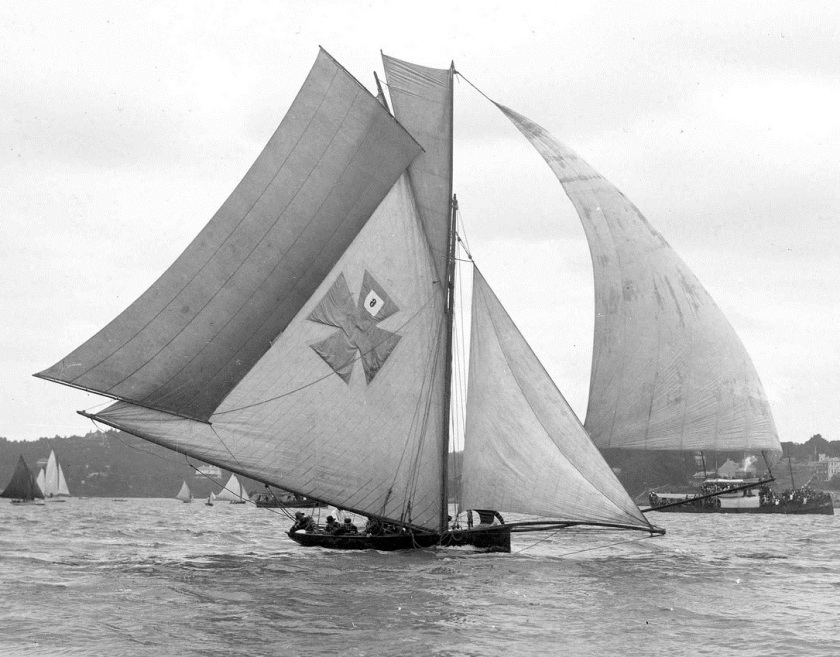
We will probably never know why Alfred Bower, that great Liverpudlian fan of Truant, decided to try to sell his boats on the other side of the world. But when Bower’s Presto arrived in Australia in 1854, it brought the racing centreboarder to new and very fertile ground, and paved the way for one of the first major developments in centreboarder design to happen outside the UK and USA. It also demonstrated the extraordinary historical links in the ancestry of the racing dinghy, for it was a boat that had been inspired by New York’s Bob Fish and built by a man who possibly learned his trade working on Peggy that introduced the centreboard racer to a new continent.
When Presto was unloaded in Sydney, the Australian colonies had a population of just 440,000 people, concentrated into a few cities scattered along a coastline longer than the USA’s, but the goldrush was on its way to making Australia the richest continent on earth. Every large city was a coastal port where by European and American standards the water was warm, the summer winds normally breezy, and the water a playground. “If a child is missing in a waterside suburb, its mother’s instinct takes her to the nearest part of the harbour, and probably the little fellow will be found in a packing case or washtub paddling out in the bay” noted one writer decades later. “The liberal application of the strap he will surely get will have no effect, mother’s arm may be worn out, the strap may be worn out, but as the sparks fly upwards, the urchin will be on the water again at the first opportunity.”[1]
Unlike the UK and America, where sailboat racing seems to have started with keel yachts, in the Australian colonies the sport of racing under sail started with regattas between working sailors like fishermen, watermen and naval and merchant seamen, using open boats fitted with temporary shallow “false” fixed keels.[9] Some of the sea captains who ran the early regattas became heroes because of their zest for competition and organisation. The first organised event was in Sydney, the oldest city in the South Pacific, in 1827. “The earliest yachting in the harbour was furnished by the boats of the ships that visited the port” veteran yachtsman Jack Want wrote in 1916. “For racing purposes these boats were fitted with false keels to enable them to stand against a breeze, and the ship’s crews, who originated the competitions, went to no end of trouble to increase the sailing qualities of these craft. Short races in the neighbourhood of the vessels were the order of the day….” [9] In the same year the first “yacht”, an open 3 tonner, was launched. The racing of open boats in front of an audience was to be a mainstay of Sydney sailing from then on. [11]
Sydney had centreboard trading schooners and a small fleet of racing cutters by the time Presto arrived in 1854, but she was the first racing centreboarder seen in the colony. Even before her first race, a 50 pound a side match race against the cutter Eclipse, Presto was causing a sensation. “She was built on an entirely new model” gushed the Sydney Morning Herald, saying that in England she “has beaten everything of her class.” From her first race in Sydney Presto was a winner.”The Presto’s sailing qualities are very superior; it is doubtful whether any boat at present in the colony is able to compete with her” was the verdict.

The early reports were a bit over-enthusiastic. Presto was inconsistent in Sydney, just as she and other centreboarders had been in Liverpool. Sometimes she capsized and sometimes she struggled, and sometimes she beat much bigger keelboats like the 12 ton cutter Mischief across the line and on handicap. Presto must have been a brute to handle in those days of stretchy ropes, baggy sails and heavy tackle, but she excited the sailors of Sydney so much that Bower started to send more of his superseded centreboarders out to the colony. Challenge arrived in Sydney in March 1855 [2], followed by Spray in 1856 [3] and then Charm. They “created a great rage for the type in the fifties” and showed the sailors of Sydney the potential of the “broad shallow craft of the skimming dish order”.
The advertisements and race reports for Bower’s boats provide the most detailed information we have about the first British-built centreboard racers. Challenge seems to have been typical. Rated at 8 tons (although this varied a lot, according to the particular rule in use) she measured 27ft4in on the keel and had a beam of 9ft. Her specifications speak of a sophisticated and expensive build; copper fastenings, “air tubes” to make her unsinkable, ballast moulded to her bottom, and (in another illustration of the cosmopolitan nature of Victorian-era sailing) sails that were imported from New York. The Bower and Kelly creations all seem to have had about 300kg/670lb of metal ballast that slid from side to side on tracks. Sometimes they relied on the ballast for stability; Challenge won some races with just four crew aboard, while on the other hand Spray used “a numerous crew, who form a shifting living ballast to preserve her from capsizing”.
Charm cost her new owners 150 pounds; not too much in those goldrush days when a trophy like the one won by Challenge in 1857 was worth over 300 pounds. Victories such as that meant that by 1859 the centreboarders were so well known that the arrival of the Charm was news throughout the colonies, taking up column space alongside the usual reports of political meetings that descended into riots, concerns about the Mayor of Melbourne’s habit of kissing young women, potentially fatal vandalism on Australia’s first railway, and other news that dispels the notion that our ancestors all fitted the cliche of the pompous and gravely dignified Victorian. [4]
Some owners of the conventional keel cruiser/racers were less happy with the arrival of the half-decked centreboarders. It was the old issue that had faced Truant – open centreboard “racing machines”, with their shifting ballast of metal and crewmen, could not really compete against deep-keel offshore cruiser/racers of very different shape and performance. Even when the centreboarders were given a minute’s handicap penalty in 30 mile races to go on top of their normal rating, the two types were too different to allow the keelboat owners “the simple justice of a fair competition with their own class”. It doesn’t seem to have been a simple case of prejudice; some of the top keelboat owners also sailed centreboarders. Eventually, the big half-deck centreboarders were moved into their own class.
And what were Sydney’s small boat sailors doing about this new crop of high-performance centreboarders, while the big-boat sailors bought them, raced them and argued about them? It seems that the small-boat sailors basically ignoring them – and not just for a few months, but for a decade or two. Perhaps because they thought the complication of a centreboard wasn’t worthwhile in the deep waters of Sydney harbour, throughout the 1860s and early 1870s the small-boat racers stayed faithful to the type they called the “deep keel dinghies”, described as “a miniature yacht without a deck, and a tuck instead of a counter”.[10] The smallest popular class was the 15 footers, which were limited to a maximum beam of 5 feet beam and a draft of 3 feet. They were described as “heavily sparred, but when launched and before the mast was stepped it would lie over on the side until stiffened with half a ton or so of ballast.”
The other popular “dinghy” classes of the 1860s had the same flawed concept; they were “deep-keeled 16 and 23 footers, without a deck or half deck, which carried lead ballast and big crews….they were undoubtedly dangerous boats…” as one sailor recalled.[11] Another who raced in a small fleet of “fixed fin” dinghies as late as 1878 recalled that “centreboards were only to be found in a very few boats” at the time.[12] As early as 1857 and as late as 1865, races for the popular 22 footers specifically banned centreboards. [13]
The centreboarders of Victoria
While the ancestors of Sydney’s skiff sailors were sailing “dinghies” that weren’t centreboarders, many of the sailors in the rival colony of Victoria were sailing centreboarders that weren’t dinghies. The centreboard arrived in Victoria via a different route, and the boats that were developed in the southern part of the continent were of a different style to the ones from Sydney and further north. It’s a split that remains today, and all too often it means that the dinghies of southern Australia are unfairly overshadowed by the skiff types that are concentrated in the north.
The centreboard had arrived in Victoria even before the land had been settled by Europeans – much of the coast, including the site of the future capital city of Melbourne, had been explored by the early experimental “sliding keel” brig HMS Lady Nelson. But for many people in the 1850s, the only important thing about fast sailing was that it allowed you go get to the goldfields as fast as possible. The colony was in the middle of one of the world’s greatest gold rushes, with Melbourne doubling its population in a single year.
It was probably gold that brought Henry Robert Murray – the same H.R. Murray who had helped to form the Birkenhead Model Yacht Club and watched Truant win – to Victoria. Murray’s arrival gave the colony the advantage of having one of the few trained designers who was familiar with centreboarders. It was an advantage that the antagonistic, apparently erratic and definitely tactless Murray did a lot to throw away.[17]
As the sailing historian Ralph Neale noted, Murray was spurred into designing shallow and beamy centreboarders when one of the colony’s yachting pioneers said that such a craft could never beat a keelboat. Murray was a man who took offence easily, and he determined to prove the pioneer wrong. As early as 1856 he was building a string of fast but poorly-prepared small centreboard yachts, starting with Eclipse (30’ overall), followed by Spray (which he later described as “with the exception of her counter, a facsimile of the Cowes Una of 1879”) Ripple (22’6”), Southern Cross and a Una boat. Their performance was erratic, but they scored some spectacular wins against bigger keelboats.
Murray became Victoria’s main early advocate for the centreboarder and the “surface sailing” principle that “the hull should skim over the surface of the water, while the immersed blade increases the lateral resistance, and enables them then in ordinary weather to hold a wind with their deep-keeled rivals.” [18] His promotion of the centreboarder may have been handicapped by the fact that he wasn’t just tactless in private; he was rude and abusive in the newspaper columns, too. A rival boat was publicly labelled a “chunk of ugliness” in one letter to an editor.[20] “One might as well try to comb snakes into drawing-room pets as to make yachtsmen out of the more wealthy classes of Victorians – at least the present generation” was just one of his more colourful public descriptions of the “old fogeys” and “Namby-pambys” of the big-boat scene.[19]
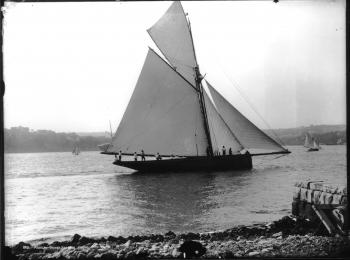
But nature may have made up for Murray’s lack of tact. Victoria is an ideal breeding ground for centreboarders. Melbourne sits on the edges of the wide and choppy expanse of Port Phillip Bay. The Bay offers superb and challenging racing conditions – some highly experienced American sailors have compared it to San Francisco Bay’s famously windy “Berkeley Circle” racecourse – but there are only two significant natural harbours on its 264km/164mile shoreline. In the days before modern marinas, clubs could lose up to 75% of their fleet when storms hit the boats moored behind the dubious shelter of shoals and small piers or breakwaters. Even today, when gales blow through some of the Melbourne’s smaller breakwater harbours are overwhelmed and moored yachts are tossed onto beaches.
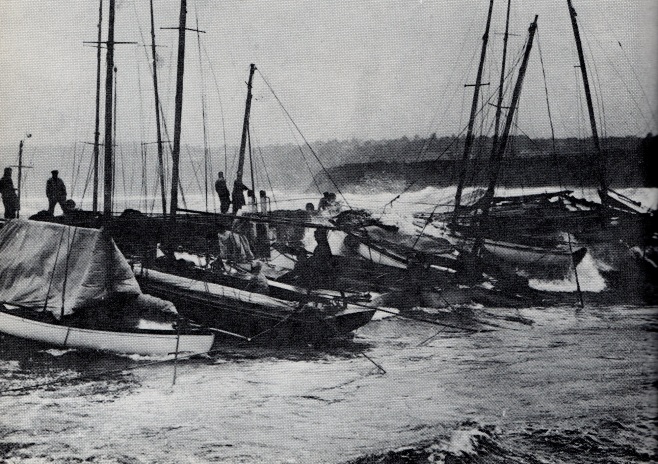
The harbourless shores and challenging conditions of Port Phillip led the sailors of Victoria to adopt a breed of centreboarder that is very different to the stereotyped Sydney “skiff” that is often wrongly thought of the classic Australian boat. The undecked, over-canvassed style of boats that were popular in Sydney could not survive on Port Phillip Bay. Victorian dinghies, like those of the neighbouring state of South Australia, are often launched over open beaches through breaking surf, and have to be able to handle short, steep waves of the type never seen in Sydney. These conditions were to eventually develop a breed of boats that were lighter, more seaworthy and arguably more efficient than their Sydney contemporaries.
But until the end of the 1800s, few true dinghies were to be seen on Port Phillip. The geography of Port Phillip Bay encouraged both yachtsmen and fishermen to build half-decked centreboard yachts of 20 to 32 feet. These big centreboarders were seaworthy enough to handle the rough conditions of the bay, shallow enough to shelter behind sandbanks, piers or in the shallows, and light enough to be pulled ashore out of harm’s way during the winter. [21] “There is very little perceptible difference in the form and proportions of the (Melbourne) centreboarders, whether flying the burgee of the St. Kilda or Brighton clubs, or the weather beaten house flags of the fishermen of Port Melbourne, Queenscliff or Hastings” noted one writer. “The club boats are, of course, a little more tastefully fitted up, and have white sails, but the hulls all bear the same family likeness.” Murray showed his versatility by designing fishing boats as well as racing yachts, and is credited with being one of the major influences in the design of the centreboarders that were used to catch Barracouta in the notoriously rough waters along the Bass Strait coast.

Perhaps because Melbourne’s limited cruising grounds didn’t encourage small cruiser/racer keelboats, the half-decked centreboarders don’t seem to have experienced opposition from the owners of fixed-keel boats, as they did in other areas. The half-decked centreboarders seem to have been accepted alongside the keelers, and they made up most of the fleet of the “establishment” yacht clubs that bear “Royal” tags today. Even the sailors who raced on tiny lakes like the 49ha/120 acre Albert Park Lake in Melbourne’s suburbs (inside today’s Formula One course) or Lake Wendouree in the inland goldrush city of Ballarat often sailed the same sort of big half-decked centreboarders as the Bay sailors. For a few years, the miners who had struck it rich around Ballarat spent their money on long, slender undecked “skiffs” and on half-decked centreboarders of 30 ft and more, sometimes fitted with shifting ballast weights like the Bower/Kelly boats. Murray also moved to Ballarat, where in typical style he not only built a catamaran years before Nat Herreshoff but also became involved in newspaper flame wars against the “nautical dogberries” and “swamp talent” of the lake and their “cuttle fish tactics” when he wasn’t throwing them into the lake while arguing about boatbuilding and money.[22]
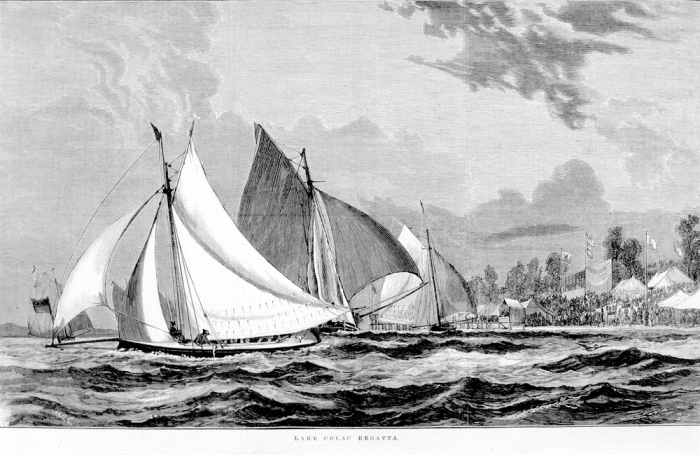
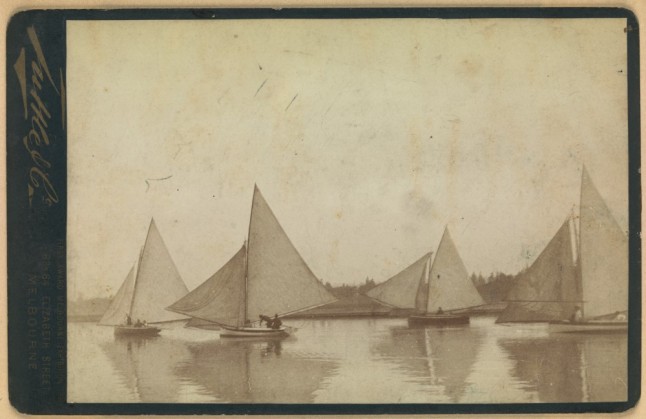
Prehistoric planers – the Connewarre Flatties
While most of the centreboarder sailing in Victoria was taking place in big boats, away from the spotlight a bunch of forgotten sailors were creating what seems to have been the first planing boat. In the mid 1800s the shallow waters of Lake Connewarre, located across the Bay from Melbourne near the booming goldrush city of Geelong, were a haven for commercial duck hunters. Like their British cousins, they used “duck punts”; long, low, slender craft, designed to allow hunters to slide along and allow hunters to quietly sneak up on unsuspecting waterfowl. Several people have proposed that the British duck punts are a candidate for the title of the “world’s first planing boat” and their modern development, the Norfolk Punt, is one of the world’s fastest dinghies. But reports and descriptions of earlier British duck punts by such authorities as Folkard (a keen wildfowler as well as sailor) and Sir Peter Scott (a wildfowler turned conservationist and Olympic dinghy medallist) seem to make it clear that the earlier British punts were low-powered craft, designed to slide efficiently down narrow waterways at fast displacement speed, and used in the freezing winter months when the hunting season was open.

Old prints and photos show that the duck hunters of Lake Connewarre had small paddling punts that were similar to the ones from “home”, as most colonists still called Britain. As late as the 1900s, similar boats were sometimes raced under small rigs around nearby Queenscliff.
In mid to late 1850s, the duck punts of Lake Connewarre started to evolve into something bigger and much, much faster. It’s not clear quite why this isolated little lake was the centre for such a development. There were no big-time boatbuilders in the area, and no external influences seem to have sparked the search for performance. It seems that the “flatties” were probably sparked by their environment – a broad expanse of water that was open to the strong and steady winds of nearby Bass Strait, shallow enough to make it hard to get into trouble and, perhaps most importantly sometimes as warm as 30 degrees in the summer months. It must have been an ideal place to push the limits of design; on Connewarre, a capsize in the sailing season was a refreshing way to cool down on a hot summer’s day, and if things got really bad you could just walk back to shore.

The only detailed account of the early flatties describes them as double enders, 17ft long with a beam of about 2’6” and a hull about one foot deep. They had a steering paddle, hard chines, flaring topsides, and sprit yawl rigs. Although early flatties seem to have had issues upwind – the paddle was sometimes needed to get them through tacks – sailors later remembered that they would “reach like a modern ‘half rater’” and “slide down the wind like only a ‘flattie’ can.”
The Connewarre sailors had their own tiny “yacht club” – an old railway shed, perhaps the first dinghy club in the country – from about 1860. Over time they developed bigger and faster flatties, until by the 1880s they were normally around 20 to 22ft long, 5ft6in to 6ft6in wide, carrying around 180ft of sail in a lug sloop rig, and had a midsection allegedly identical to a later Seawanhaka Cup scow.[23] They carried four or more hard-hiking crewman who drove them hard on the normally warm and shallow lake.
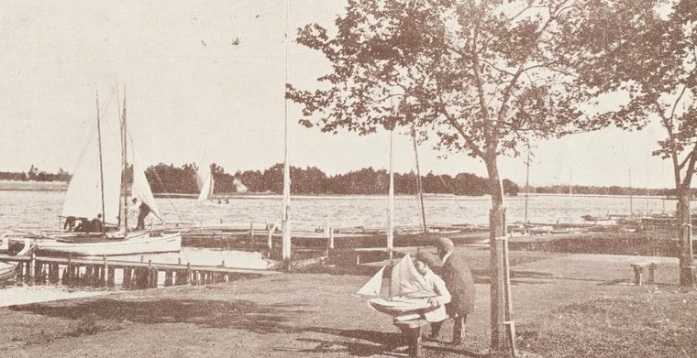
If you make a boat flat enough and give it enough power, it’s almost certain to plane, and that’s what the flatties seem to have done. A retrospective account by local sailor George Brewer of a hard race about 1880 speaks of a flattie with its “bow lifted, sliding on her V shaped section (that) seemed to blow over the water like a mass of spume.”[24] If such descriptions came only from an ageing former flattie sailor they could be written off as exaggerations, but independent sources back them up. A writer for a Melbourne newspaper who had seen the flatties in action wrote in 1884 of their “aerial flights when the pace is forced to a certain degree” and spoke of them beating the big-rigged 32 footer centreboarders on other lakes. [25] Another independent observer of 1884 noted the flatties’ “immense sail area, on a very small displacement” and that “the principal sailing feature of the Connewarra craft is the fact of their bottom amidships for 18 inches being almost a dead flat, and tapering up towards the bow in the form of an inclined plane. This peculiar build, when the boats are sailing beyond a five knot speed, and when the wind strikes their mainsail at a right angle with the keel, causes them to rise bodily from the water, and they are said to frequently attain a speed of from 12 to 14 knots.”[26] This sounds exactly like a description of a boat rising onto the plane around the time it reaches its hull speed, and the reference to wind direction indicates that (as one of Brewer’s accounts says) they could even plane on a beam reach.


The Connewarre flatties seem to have been the first sailboat to commonly plane – but they are utterly lost to history. They were, as even their fans said, “not built for rough water, but…an inland lake boat”; and in a land where there were few wide lakes where they could show their performance, they were an endangered species.[27] In the 1890s the flatties, like the conventional fishing boats of the lake, died out; victims of changes to the lake and, Brewer said, of the craze for horse racing.[28] The flatties were soon completely gone and almost utterly forgotten. Apart from some very brief mentions in Ralph Neale’s excellent early history of Victorian sailing, they have been erased from the history books, and their significance as the first recorded planing boat has gone unknown. As far as their effect on the history of the sport goes, they may as well never have existed. They had nothing like the impact that the Oxford Canoe Yawls seem to have had, in terms of inspiring other sailors to create planing hulls.
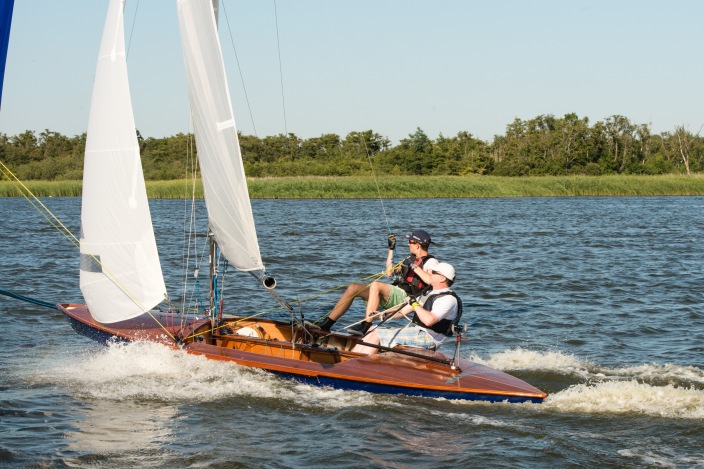
But before they died, the flatties joined in on the spirited centreboarder racing circuit that briefly flowered on Victoria’s various small lakes, with boats being dragged around the colony aboard railway trains and carts. Rarely can such small regattas have caused so much rich abuse to be thrown in so many directions by so few sailors. Representatives from every area and boat type leapt happily at the chance to slander each other in the press. To Murray, the half-decked centreboarders of Port Phillip were “baskety so-called yachts”, little more than “the commonest type of fishing boats” and products of “spiritless clubs” full of “selfish conservatism”. [29] To sailors from England and the coastal cities, the clinker Ballarat boats and their “movable ballast box” were un-yachtie ”clencher used-up passenger boats”.[30] Some of the Ballarat sailors sneered at requests to put the unballasted “skiffs” in their own class to give the ballasted half-deckers from Melbourne a chance, saying that they favoured “more open competition rather than giving “the veriest tub and crew of incapables” a chance. When the Ballarat boats were beaten by the flatties, the Ballarat sailors changed their tune and banned the Connewarre boats on the charge that they were not real boats. The Connewarre sailors, who had been thrown out from the big Lake Colac regatta on the same grounds, retaliated by pointing out that the “clench built long boxes” of Ballarat were not true yachts either, and that Wendouree’s latest “so called yachts” Flying Scud and Flaneur had the same midsection as the latest flatties.[31][32]
The Victorian centreboarder scene of the late 1800s was colourful, vibrant, controversial – and, perhaps due to the clash of personalities, much of it faded away. The goldrush was followed by an economic crash. Murray, who for all his faults sounds like a fascinating man, died poor after grubby arguments with business partners – one was convicted of writing graffiti insulting the yacht builder on Melbourne walls. The lakes filled with weeds and shoals, killing the flatties and stymying the Ballarat and Albert Park fleets. Today, the Connewarre flatties and Ballarat skiffs have been forgotten, and Victorian sailing is centred around lightweight dinghies and conventional yachts and trailer sailers.

In recent decades the traditional half-decked fisherman’s “Couta Boats” that Murray helped to develop have been revived and transformed into one of the most popular classes in Victoria, with small but growing fleets in other states. They have become a sailing and high-society institution along the wealthy weekend resorts of the southern shore of Port Phillip Bay, racing in fleets of 50 or more and attracting Olympic and America’s Cup sailors, world champions from performance dinghies, and many of the most successful businessmen in the country. Seeing these 20-28 footers wafting at surprising speed through an evening breeze under their huge gaff mains takes you back in time to the days of Murray, the “swamp talent”, the flatties and “so-called yachts”; an era that ensured that the centreboarder became an established part of sailboat racing in the southern part of Australia, an area that was to play a significant part in the development of the racing dinghy.
For the next part in the story of the Australian racing dinghy and skiff, go here.
References

“She was built on an entirely new model” SMH 1 April 1854
“For some reason, in 1854 Alfred Bower of Liverpool”. The exact way Preso arrived is unclear. Some sources (eg Sydney Mail, 30 Jan 1897) say that she was brought out by Sydney yachtsman and auctioneer Sydney Burt, but the later ads for the Bower boats say that he sent Presto out.
“The Presto’s sailing qualities are very superior; it is doubtful whether any boat at present in the colony is able to compete with her” 8 April 1854 Illustrated Sydney News
“she was the first racing centreboarder seen in the colony” see for example Sydney Mail and New South Wales Advertiser, 30 January 1897 p 228
“created a great rage for the type in the fifties” Sydney Mail 30 jan 1897
[2] (ad in Empre, 27 Marc 55 p 7). Charm carried “considerably more canvas’ than presto, challenge, spray; bells life in sydn=sporting reviwrewe 1 jan 1859 p 5.
MAR 1855 CHALLEGE came from Li erpool
“a broad shallow craft of hte skimming dish order”. Sydney Mail 30 jan 1897. This is an outstanding interesting article, based on interviews with many of Australia’s original yachtsmen. The same source says that Preso was biult in America, which is clearly incorrect but does reflect the American style and influence in her design.
[3] Sydney Morning Herald, 20 Sep 1856 p 1
[4] Moreton Bayt Courier, 12 Jan 1859 p 4
“the simple justice of a fair competition with their own class” SMH 36 Jan 1858
[5]Bell’s Life in Sydney and Sporting Reviewer (NSW : 1845 – 1860)
| Previous issueSaturday 7 February 1857 |
“Some owners of the conventional keel cruiser/racers were less happy with the arrival of the half-decked centreboarders”; see for example Empire, 25 Oct 1856
“It doesn’t seem to have been a simple case of prejudice”: – for example Sydney C Burt, a successful keelboat owner, owned Presto and may have been the person who imported her (although later ads for Bower’s boats state that he sent her out) and also had the open 13 ton centreboarder Scud imported from the USA, according to the Sydney Morning Herald of 21 Sept 1865. Richard Harnett, who designed the very advanced keelboat Australia, skippered Presto early on and appears to have owned Scud as well from the fact that he had her auctioned according to an ad in the Sydney Morning Herald of 12 Jan 1859. Both Burt and Harnett were two of the leading names among the 19 foundation members of the “establishment” Royal Sydney Yacht Squadron.
[6] Sydney Morning Herald 1 Feb 1858 p 4
[7] Sydney Mail and New South Wales Advertiser, 30 Jan 1897 p 233
[8] Sydney Mail and New South Wales Advertister, 30 jan 1897 p 228. This article written with first hand information from several of Sydney’s pioneer yachtsmen, including Richard Harnett.
[9] Illustrated Sydney News, 15 April 1886 p 10;
[10] “Evolution of the Broad tucked boat”, The Sydney Mail and New South Wales Advertiser, 5 Jan 1910 p 36
[11] “Port Jackson’s Pleasure Fleets” No 1” Evening News, 12 Oct 1907 p
“They were described as “heavily sparred…”; in ‘Sailing History, the evolution of 18 Footers’, The Sun (Syd) 16 Dec 1913, p 12
[12] Australian Motor Boat and Yachting Monthly, June 1927 p 9.
[13] See for example Sydney Mail, 2 December, 1865 p 9 re Balmain regatta
[14] The Australasian, 18 April 1896 p 17
[15] “Jolly Dogs are We: The History of Yachting in Victoria 1838-1894”, Ralph Neale, Mont Albert, 1984
[16] 15 died in the typical 28’ centreboard fishing boat Process when she capsized under racing sails while taking a football team back from a match; Ballarat Star, 24 May 1892 p 2. The owner/skipper’s brother and 3 crewmen were lost in her sistership capsize in a regatta in 1897; The Australasian 24 April 1897 p 19
[17] There were centreboard yachts in Victoria before Murray appears to have arrived on the scene, just as there were centreboard coastal trading schooners in Sydney. A 6 ton centreboard yacht was for sale in Melbourne as early as 1854; The Argus, 25 Feb 1854 p 2. However, there appears to be little doubt that Murray took the leading role in creating centreboarders, especially ones of shallow hull form.
[18] The Australasian (Melb) 11 Jan 1868 p 12
[19][19] Sydney Mail and New South Wales Advertiser, 4 Dec 1886 p 1185. Although the owners of his boats seemed loyal to him, one of his partners ended up walking about city streets, chalking up accusations that Murray was “a jail bird and a swindler”; The Age, 1 Feb 1883 p 6.
[20] The Australasian, 11 Jan 1868 p 12
[21] Ballarat Star, 7 Aug 1865 p 2
[22] Ballarat Courier, 15 Sept 1877 p 4; Leader, 13 August 1864 p 17
“Murray showed his versatility by designing fishing boats”. Details of Murray’s important role in developing the Couta Boat are to be found in “First Home: The Couta Boat and Victoria’s Couta Coast”, Micheal Innes and Steve Burnham (eds) St Kilda 2005. The early Couta boats have much steeper deadrise than the “surface sailing” boats that Murray appears to have normally copied, but he was a very versatile designer and it would have been logical for him to develop a very different hull shape given the Couta Boat’s role.
“There is very little perceptible difference”; Leader (Melbourne, Vic. : 1862 – 1918), Saturday 11 February 1888, page 21
Folkard, in The Sailing Boat p 344-5, advised that a Punt’s mast should be the thickness of a mop handle, and only about as tall, and light enough to snap instead of capsizing the mast. Although Folkard noted that “The rapidity with which a little boat of this kind”skims along on a reach in smooth water is astonishing”, he also noted that it would nosedive if pressed hard in waves, and that “no reasonable man would venture to sail in so frail a bark in rought water” .
The sailors of Lake Connewarre had similar duck punts ; see Hammers Back The official Newsletter of the Vintagers (Australian Chapter) Issue No. 32 – June 2009, p 4.
[23] Geelong Advertiser of 1904’s series “Memories of old Geelong; the Connewarre Flatties” by Geo. Brewer, 3 Sept 1904 p 4. It’s interesting to note that this breakthrought was achieved despite the flatties having class rules regarding their hull shape;
[24] Geelong Advertister, 12 Nov 1904 p 4
[25] Leader (Melbourne) 31 May 1884 p 17. This is the source that mentions they had “centreplates”; Australian Town and Country Journal 3 Feb 1883 p 35
[26] Leader (Melbourne) 31 May 1884 p 22
[27] Leader (Melb) 14 April 1888 p 21
[28] Brewer and Geelong Advertiser, 5 Aug 1911 p 10
[29] Portland Guardian, 10 April 1891 p 3.
[30] The Ballarat Star, 4 Nov 1879 p 4
[31] Leader (Melb) 24 Nov 1883 p 21
[32] The Ballarat Star, 21 June
The early details of small boat racing in Melbourne are lost; we know there were races as early as 1858 but even Ralph Neal’s excellent history gives no details. [15] [16]

This is a most excellent sailing blog with detailed, in depth articles. It makes for brilliant reading.
LikeLike
Thanks very much for that, Dick,. it’s most appreciated! By the way, I’d always be interested in hearing from you about any mistakes I make about traditional rigs (or in fact any other area). I’ve used gunter and gaff a little bit and a lug rig once, so I’m pretty much in the dark about them.
LikeLike